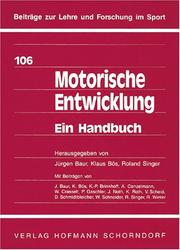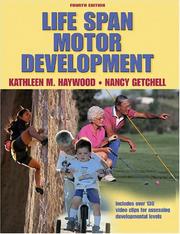| Listing 1 - 10 of 167 | << page >> |
Sort by
|
Book
ISBN: 9053832432 9789053832431 Year: 1994 Publisher: Amsterdam: VU,
Abstract | Keywords | Export | Availability | Bookmark
 Loading...
Loading...Choose an application
- Reference Manager
- EndNote
- RefWorks (Direct export to RefWorks)
Book
ISBN: 0471087785 Year: 1982 Publisher: New York (N.Y.) : Wiley,
Abstract | Keywords | Export | Availability | Bookmark
 Loading...
Loading...Choose an application
- Reference Manager
- EndNote
- RefWorks (Direct export to RefWorks)
Multi
ISBN: 9781437715484 1437715486 1336229624 9781336229624 9781416049784 1416049789 Year: 2012 Publisher: Saint Louis, Mo. : Elsevier/Saunders,
Abstract | Keywords | Export | Availability | Bookmark
 Loading...
Loading...Choose an application
- Reference Manager
- EndNote
- RefWorks (Direct export to RefWorks)
Providing a solid foundation in the normal development of functional movement, Functional Movement Development Across the Life Span, 3rd Edition helps you recognize and understand movement disorders and effectively manage patients with abnormal motor function. It begins with coverage of basic theory, motor development and motor control, and evaluation of function, then discusses the body systems contributing to functional movement, and defines functional movement outcomes in terms of age, vital functions, posture and balance, locomotion, prehension, and health and illness. This editi

ISBN: 3778015613 Year: 1994 Publisher: Schorndorf Karel Hofmann
Abstract | Keywords | Export | Availability | Bookmark
 Loading...
Loading...Choose an application
- Reference Manager
- EndNote
- RefWorks (Direct export to RefWorks)

ISBN: 0736055746 Year: 2005 Publisher: Champaign Human kinetics
Abstract | Keywords | Export | Availability | Bookmark
 Loading...
Loading...Choose an application
- Reference Manager
- EndNote
- RefWorks (Direct export to RefWorks)
Book
Year: 2006 Publisher: Champaign, IL : Human Kinetics,
Abstract | Keywords | Export | Availability | Bookmark
 Loading...
Loading...Choose an application
- Reference Manager
- EndNote
- RefWorks (Direct export to RefWorks)
Infant Motor Development is the first text to concentrate on motor development during infancy--the stage in which the greatest qualitative changes in the life span occur. It is an excellent introduction to the most relevant and common issues researchers, clinicians, and parents face. This groundbreaking text combines theory with application to provide the most current account of infant motor ability and disability--including the latest prenatal research--all in one comprehensive resource. Infant Motor Development presents criteria for selecting the most appropriate assessment tool and intervention strategies to improve the motor functioning of infants with particular problems. The result is an essential textbook for graduate students and an up-to-the-minute reference for health professionals and researchers. Infant Motor Development is organized into four parts covering theory, research, assessment, and intervention. It integrates information from a variety of disciplines to encourage a broad understanding of infant motor development. Topics include the development of voluntary movements such as posture, stability, balance, and orientation; manual control of reaching and grasping; locomotor control of creeping and walking; the unique difficulties faced by premature infants; and an examination of two disabilities with devastating consequences to motor control: cerebral palsy and Down syndrome. Infant Motor Development contains many helpful features: Sidebars highlighting the relationship between research and therapeutic practice; Chapter objectives and summaries that clarify the main ideas and simplify the review process; Key points that highlight important concepts throughout the text; Glossary of terms that clearly defines the concepts used in infant motor development. With Infant Motor Development, students will understand the subject area from a variety of disciplines and perspectives, researchers will discover the most current theory and findings, and clinicians will learn to apply theory and research in their work with infants.
Book
ISBN: 9781492595151 9780736073936 Year: 2012 Publisher: Champaign Human Kinetics
Abstract | Keywords | Export | Availability | Bookmark
 Loading...
Loading...Choose an application
- Reference Manager
- EndNote
- RefWorks (Direct export to RefWorks)
Advanced Analysis of Motor Development explores how research is conducted in testing major issues and questions in motor development. It also looks at the evolution of research in the field, its current status, and possible future directions. This text is one of the few to examine motor development models and theories analytically while providing a context for advanced students in motor development so they can understand current and classic research in the field. Traditionally, graduate study in motor development has been approached through a compilation of readings from various sources. This text meets the need for in-depth study in a more cohesive manner by presenting parallels and highlighting relationships among research studies that independent readings might not provide. In addition, Advanced Analysis of Motor Development builds a foundation in the theories and approaches in the field and demonstrates how they drive contemporary research in motor development. A valuable text for graduate students beginning their own research projects or making the transition from student to researcher, this text focuses on examining and interpreting research in the field. Respected researchers Haywood, Roberton, and Getchell explain the history and evolution of the field and articulate key research issues. As they examine each of the main models and theories that have influenced the field, they share how motor development research can be applied to the fields of physical education, special education, physical therapy, and rehabilitation sciences. With its emphasis on critical inquiry, Advanced Analysis of Motor Development will help students examine important topics and questions in the field in a more sophisticated manner. They will learn to analyze research methods and results as they deepen their understanding of developmental phenomena. For each category of movement skills covered (posture and balance, foot locomotion, ballistic skills, and manipulative skills), the authors first offer a survey of the pertinent research and then present an in-depth discussion of the landmark studies. In analyzing these studies, students will come to appreciate the detail of research and begin to explore possibilities for their own future research. Throughout the text, special elements help students focus on analysis. Tips for Novice Researchers sidebars highlight issues and questions raised by research and offer suggestions for further exploration and study. Comparative tables detail the differences in the purpose, methods, and results of key studies to help students understand not only what the studies found but also the relevance of those findings. With Advanced Analysis of Motor Development, readers will discover how research focusing on the major issues and central questions in motor development is produced and begin to conceptualize their own research. Readers will encounter the most important models and theories; dissect some of the seminal and recent articles that test these models and theories; and examine issues such as nature and nurture, discontinuity and continuity, and progression and regression. Advanced Analysis of Motor Development will guide students to a deeper understanding of research in life span motor development and enable them to examine how the complexities of motor development can be addressed in their respective professions.
Motor ability in children. --- Human development. --- Motor ability. --- Motor ability in children --- Human development --- Motor ability
Book
ISBN: 0812105834 Year: 1977 Publisher: Philadelphia (Pa.) : Lea and Febiger,
Abstract | Keywords | Export | Availability | Bookmark
 Loading...
Loading...Choose an application
- Reference Manager
- EndNote
- RefWorks (Direct export to RefWorks)
Child development. --- Motor ability in children. --- Physical education for children.
Book
ISBN: 2749256666 Year: 2017 Publisher: Toulouse, France : Érès,
Abstract | Keywords | Export | Availability | Bookmark
 Loading...
Loading...Choose an application
- Reference Manager
- EndNote
- RefWorks (Direct export to RefWorks)
Ce livre présente les recherches d'Emmi Pikler sur le développement moteur et la mobilité ainsi que des études plus récentes, sur l'hyperactivité, l'attention, la manipulation, l'humour. Elles se fondent, et ce n'est pas courant, sur l'observation de l'activité spontanée de l'enfant dans son milieu de vie. Présentées par Raymonde Caffari à l'intention des lecteurs d'aujourd'hui, largement illustrées par des photos noir et blanc et des dessins à la fois précis et poétiques, les recherches d'Emmi Pikler et de ses disciples montrent que, par son activité motrice spontanée, le bébé maîtrise progressivement, et de manière harmonieuse, mouvements et postures. Auprès des adultes bienveillants qui ont confiance en lui, il construit ainsi son développement global : psychomoteur, cognitif, psychique. Longtemps inaccessibles au public français, ces recherches, aujourd'hui encore originales dans leur sujet et dans leur méthodologie, complétées par des études récentes, dressent un tableau presque complet de l'activité spontanée des petits enfants et de leurs capacités d'auto-développement.
Cognition in children. --- Motor ability in children. --- Child development.
Book
ISBN: 2749261929 Year: 2018 Publisher: Toulouse (33 avenue Marcel Dassault 31500) : Érès,
Abstract | Keywords | Export | Availability | Bookmark
 Loading...
Loading...Choose an application
- Reference Manager
- EndNote
- RefWorks (Direct export to RefWorks)
Stimulés ou pas, tous les bébés en bonne santé parviennent à marcher, sans que l'on ait besoin de leur apprendre. Toutefois, l'attitude des personnes qui les entourent peut favoriser ou freiner l'installation d'une bonne motricité. Forte de son expérience de kinésithérapeute, l'auteur répond aux nombreuses questions que se posent les parents et les professionnels de la petite enfance : Le passage par le quatre pattes est-il important ? Faut-il aider le bébé à se mettre debout ou à marcher ? Doit-on s'inquiéter d'un petit retard d'installation de la marche ? Comment faire face à un bébé en difficulté ? Cet ouvrage vivant et pédagogique, largement illustré de photos et de dessins, incite à mieux observer les tout-petits, à s'émerveiller devant leurs exploits moteurs, mais aussi à agir au bon moment en cas d'inquiétude. Il propose des conseils pour la vie quotidienne, pour le choix du matériel et des objets à mettre à disposition, mais aussi des jeux moteurs simples, faciles à partager, afin de donner au bébé toutes les chances d'être à l'aise dans son corps avant de savoir marcher.
Child development. --- Motor ability in children. --- Movement disorders in children.
| Listing 1 - 10 of 167 | << page >> |
Sort by
|

 Search
Search Feedback
Feedback About UniCat
About UniCat  Help
Help News
News